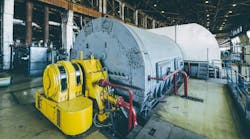ALEXANDRIA, VA, JUNE 19, 2018 -- The Water Environment Federation (WEF) has announced that Braden Milford has won the 2018 U.S. Stockholm Junior Water Prize (SJWP), the nation's most prestigious youth competition for water-related research.
Milford, a student at Cascia Hall Preparatory School in Tulsa, Okla., developed a system using naturally occurring bacteria to remove heavy metals from contaminated abandoned mine sites. He won $10,000 and an all-expenses paid trip to Stockholm to represent the United States at the international competition in late August.
Students from 47 states and Puerto Rico competed in the national finals June 16-17 at the University of North Carolina at Charlotte. The Stockholm Junior Water Prize aims to increase students' interest in water issues, research, and careers, as well as to raise awareness about global water challenges. The competition is open to projects focused on improving water quality, water resource management, water protection, and drinking water and wastewater treatment.
RELATED
Drinking water bacteria detection system wins Stockholm Junior Water Prize
Nature-inspired water tech bags Thai students Stockholm Junior Water Prize
The two U.S. runners-up were Anjali Chadha of duPont Manual High School in Louisville, Ky., and Michelle Xing of Great Neck South High School in Lake Success, N.Y., who each received $1,000. Madeline Kane of the Zoo Academy in Omaha, Neb., received the Bjorn von Euler Innovation in Water Scholarship Award from Xylem Inc. Helen Laird of Interior District Education of Alaska received the James L. Condon Recognition for Environmental Stewardship.
"WEF is proud to support and encourage these young researchers who have chosen to use their talents and energy to develop solutions to protect and preserve our water resources," said Eileen O'Neill, WEF Executive Director. "The inventive approaches these students use to tackle longstanding issues facing the water sector is both impressive and inspiring."
In his winning paper, Designing a Novel Heavy Metal Bioremediation System Utilizing Immobilized Algae Partnered with Heavy Metal Resistant Microbial Isolates Collected From Contaminated Superfund Mine Sites and Identified with a 16S Ribosomal Subunit Analysis, Milford noted that heavy metal contamination is found at nearly every one of the estimated 500,000 abandoned mine sites in the United States. Of these mine sites, 0.003% are actively funded for cleanup by the U.S. Environmental Protection Agency and cost $300 million annually. Milford used a five-phase approach to address this problem. After identifying areas of heavy metal concentration along streams near abandoned mine sites and taking samples of the water, Milford identified heavy metal-resistant bacteria. He then combined the bacteria with algae to develop a heavy metal remediation system.
In the U.S., WEF and its Member Associations organize the regional, state, and national competitions with support from Xylem Inc., who also sponsors the international competition.


